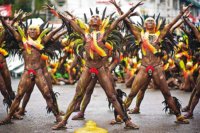Panay : Where Fun and Festivities Never End
Panay can boast of having the most number of festivities that have caught the fancy of the world. They include the famous Ati-Atihan and Dinagyang – whose revelries are balanced by idyllic beaches, coral reefs, caves, springs, and rolling hills.
Panay is a Visayan Island divided into four provinces --Antique, Capiz, Iloilo and Aklan.
Aklan is considered to be the oldest province in the Philippines having been organized by Bornean settlers in 1213 A.D.
It was this land that inspired the Malaya or Borneans to father two great cultural contributions -- the Code of Kalantiaw, which is the best known among the country’s ancient code of laws, and the riotous Ati Festival.
Historians believe that the first grand Ati celebration happened more than 300 years ago when the Malaya, under Datu Puti, purchased the island of Panay from Marikudo, the head of the aborigines, the Ati (also called the Negritoes).
Then both tribes celebrated the occasion by dancing for three days. The Spaniards who came later introduced a Christian element into the ethnic exercise. They made to coincide with the January feast day of Sto. Nino.
Today, when authentic Atis are hard to find, modern day participants paint their bodies black and wear exotic exaggeratedly-colored costumes. The event is now called “Ati-atihan”, literally meaning “Faking Atis” although the spirit remains as exuberant as it has always been.
In the late 60s, Iloilo borrowed the Ati-atihan concept and called it “Dinagyang”. Celebrated every fourth week of January, Dinagyang features a fluvial procession in honor of Sto. Nino and a costume parade that transforms the city into a vast arena of gaiety – an organized dancing.

Panay Ati-Atihan Festival
With this, one will be tempted to join the Panay locals who passionately chant “Viva Senor Sto. Nino! Hala Bira!, who prance and dance to drumbeats.
Dinagyang may not be as ancient as Aklan’s Ati-atihan, but it is equally reflective of local artistry, and said to be more impressive in choreography.
The other New Year’s sparklers in Iloilo are the Pasungay and the Fireworks Contest. Pasungay, held every second Saturday of January, is a festival of bulls on the hillside of San Joaquin, Iloilo, where bulls from the town and neighboring areas fight amid cheering spectators. Nothing gory in the festivity since the bulls are trained when to stop showing off their “combative skills”.
The Fireworks Contest, on the other hand, is held every Sunday of January and sets off dazzling pyrotechnic effects seen within a radius of several kilometers.
Also in Iloilo, visitors can witness a special parade of Nuestra Senora dela Candelaria every Feb. 2. Iloilo City's Paraw regatta, a thrilling exhibition and race of showy sleek native sailboats, falls on the second Sunday of February.
Guimaras Island, a sub-province of Iloilo, observes Lent via the “Pagtataltal,” a passion play wherein faith and foloklore are colorfully blended. It is considered as the Visayan counterpart of Germany’s Oberammergau Passion Play.
The period from last week of April to first week of May makes Antique province celebrate Binayaran Festival. This three-day folk ritual commemorates the arrival of the 10 Bornean Datus in Panay Island in the 13th century.
Capiz province holds a similar affair but calls it “Halaran”.
May-time in Iloilo showcases the Pavia Carabao-Carozza Race. In this festivity, the national beast of burden becomes “king” or “queen”, as the case may be. The best cast and muse are decked with flowers, fruits, leaves and even perfume.
A cultural vignette in Panay is the Mundo Dance of the mountain tribesmen of Capiz’s Tupaz town. These people are vanishing remnants of the pro-Malaya-Indonesia immigration. (PNA)


